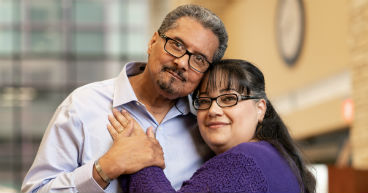
When you’re in pain, it may seem as if nothing else matters. Whether it’s a dull ache or a stronger sensation, pain may interfere with your ability to enjoy life and even function normally from day to day. Yet, for millions of Americans living in chronic pain, pain has become a way of life.
More than one in four Americans suffers from pain on a daily basis, often to the point that it interferes with sleep, work, concentration, exercise and socialization. In time, chronic pain may also lead to loss of self-esteem, depression, anxiety and even isolation, especially when sufferers find others have a hard time relating to and understanding their hardship.
Many cancer patients can identify with these struggles, since pain is a common side effect of cancer. Cancer-related pain may have several causes, including:
- Surgical wounds
- Metastatic cancer that has spread to various organs or bone
- Tumors that clog blood or lymph vessels
- Tumors that press on bones or organs
- Stress that causes muscle aches or headaches
The most common types of pain include arthritis, lower back, bone/joint pain and muscle pain, although pain may also take on many forms, changing locations or intensity daily or even hourly in the same person.
Pain management
Finding appropriate long-term solutions is a challenge that makes chronic pain even more difficult for some patients to deal with. Over-the-counter and prescription drugs remain among the most popular treatments, with 84 percent and 60 percent of pain sufferers trying them, respectively, according to an ABCNews/USA Today/Stanford University Medical Center poll. However, side effects and lingering pain may continue to be a problem.
In fact, the same poll found that only 59 percent of those who saw a doctor for chronic pain received a “good amount” of pain relief, while 11 percent felt they had “hardly any control” or “no control at all” over their pain—a frustrating and often debilitating situation to be in.
A number of pain relief options are available, including non-narcotic pain drugs and nerve blocks. But because pain can be such a complex issue to treat, methods that may work on someone else may not give you the relief you need.
Below are some safe and natural options that are available to just about everybody. And while they may not take away your pain completely, they may provide temporary relief or at least ease the pain you’ve been experiencing.
Meditation
Meditation is designed to help keep your mind focused on the present, which may make the pain less intense. Originating in Eastern spiritual traditions, meditation is now a common form of behavioral health practiced by people of many cultural and religious backgrounds.
A study by researchers from England’s University of Manchester concluded that people who regularly meditated found pain to be less unpleasant, possibly because they spent less time anticipating it, thereby blunting its emotional impact.
A separate study found that after just a single hour of mindfulness meditation training over a three-day period, participants felt less pain while meditating and also experienced less pain sensitivity when they were not meditating.
Local classes on the basics of meditation are now offered in many cities, but you can get started by finding a quiet location, sitting in a comfortable posture, then focusing your attention on your breath, an object or a mantra (a meaningful word or phrase). If you find your mind wandering, simply bring it back to your focal point without judgment. Prayer, tai chi, qi gong, yoga and journaling may also offer meditative benefits, so choose the form that feels appropriate to you.
Acupuncture
Acupuncture, an ancient form of traditional Chinese medicine, involves inserting thin needles into the body to stimulate specific points and regulate the flow of “qi” (vital energy) throughout the body. This practice is widely used for many types of pain, ranging from low back pain and carpal tunnel syndrome to osteoarthritis and fibromyalgia.
Research indicates that acupuncture may help with:
- Treatment of joint pain and stiffness in breast cancer patients
- Osteoarthritis of the knee or hip
- Chronic headaches and migraines
- Low back pain
Whether some of the benefits of acupuncture may be realized through a “placebo effect” remains to be seen, but either way, many people report that the practice has helped them.
Healthy diet
By choosing your food carefully, you may help to prevent inflammation in your body, a condition that may lead to physical pain in your muscles, joints and tissues over time. Chronic inflammation is a leading cause of numerous chronic diseases and pain.
Highly processed and high-sugar junk foods, such as pastries, French fries, candy, soda, fast food, refined white flour, etc., promote inflammation in your body, whereas fruits and vegetables are naturally anti-inflammatory.
Massage therapy
Massage therapists use a variety of techniques, including kneading, tapping, pressure and deep circular movements, to relieve a variety of conditions, including pain. A 2016 article in the journal Pain Medicine suggests that “massage therapy “should be strongly recommended as a pain management option.”
Further, according to the American Massage Therapy Association, massage stimulates the brain to produce endorphins (natural pain-relieving chemicals), and studies have shown that massage therapy may promote relaxation and alleviate the perception of pain and anxiety in cancer patients while also providing some immediate pain relief for patients with advanced cancer.
Look for a reputable and qualified massage therapist who is experienced in helping with pain relief.
Chiropractic care
Neck pain, back pain and headaches are among the primary reasons that people first visit a chiropractor, especially since chiropractic care may help the spine and other body parts get back into proper alignment, which helps relieve pain and supports the body’s natural healing processes.
According to the American Chiropractic Association, studies have shown that patients treated by chiropractors for low back pain had greater improvement after one month than patients treated by family physicians. Chiropractic care may also help provide significant relief for headache pain, neck pain and joint pain.
Exercise
Exercise may help trigger the release of pain-relieving endorphins, which may help to block pain signals from reaching the brain. Exercise also may boost your mood, strengthen bones, muscles and tissues around joints, and give you more energy.
Regular exercise may also help with weight control, which may be beneficial for certain types of pain, especially joint pain and back pain.
Research studies show that among patients with rheumatoid arthritis, for instance, aerobic and strength training exercises helped improve endurance, strength and functional ability.
If you’re in pain, be careful not to overdo exercise or engage in high-impact activities that could worsen your condition. Gentler forms of exercise, such as yoga, may also be rotated into your routine. Talk to your doctor before starting any new exercise regimen.


